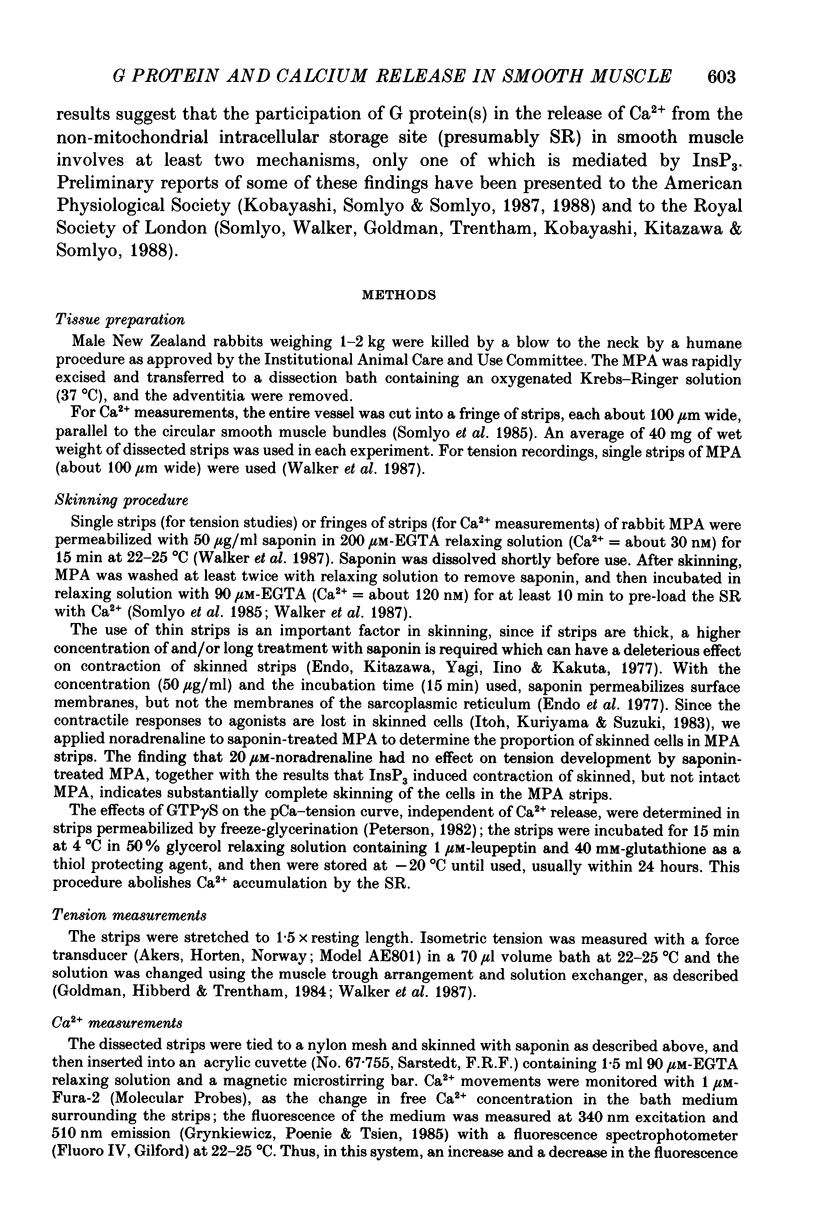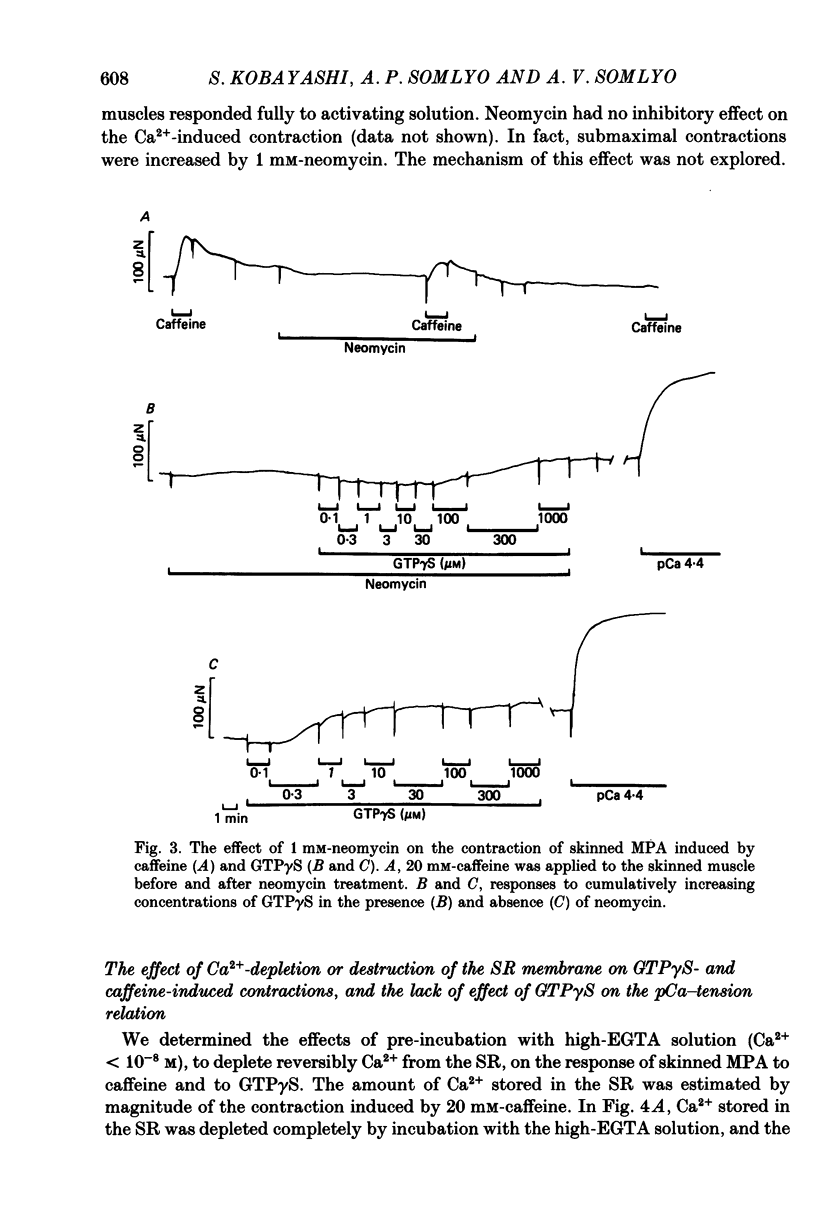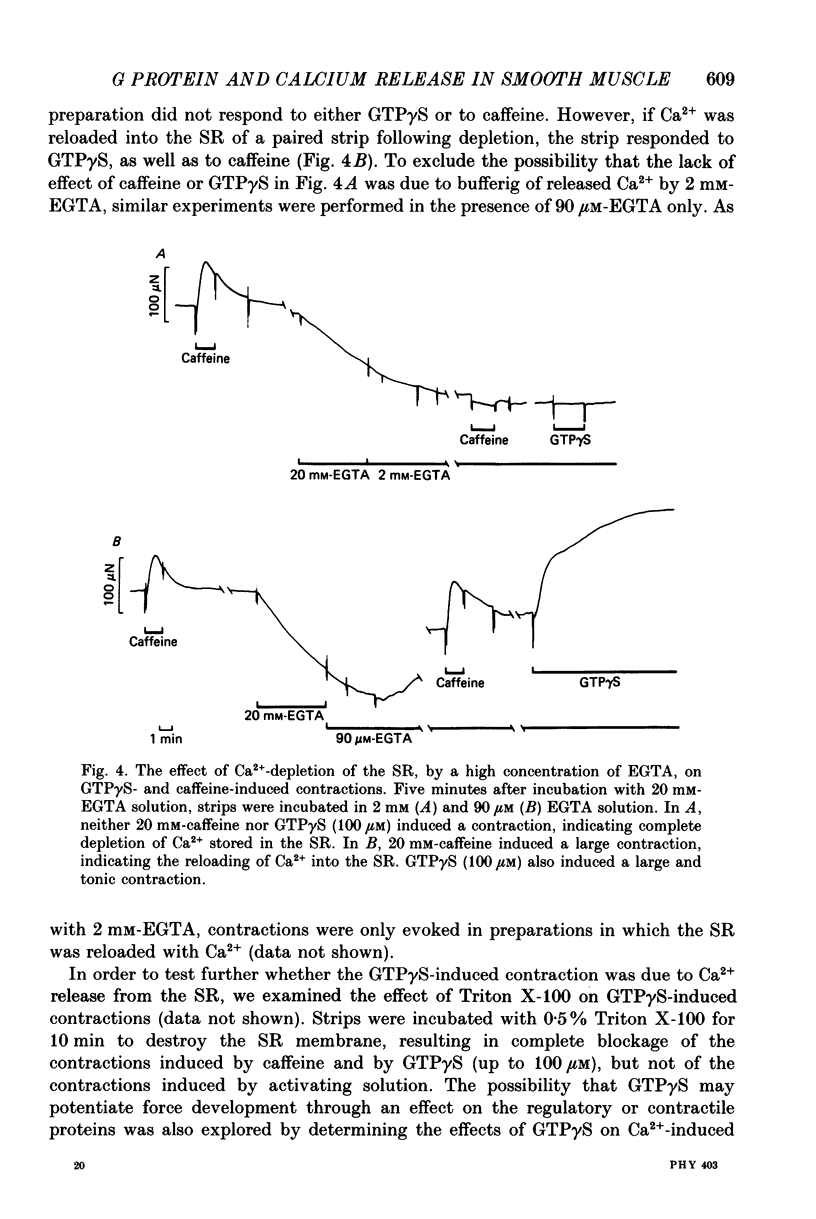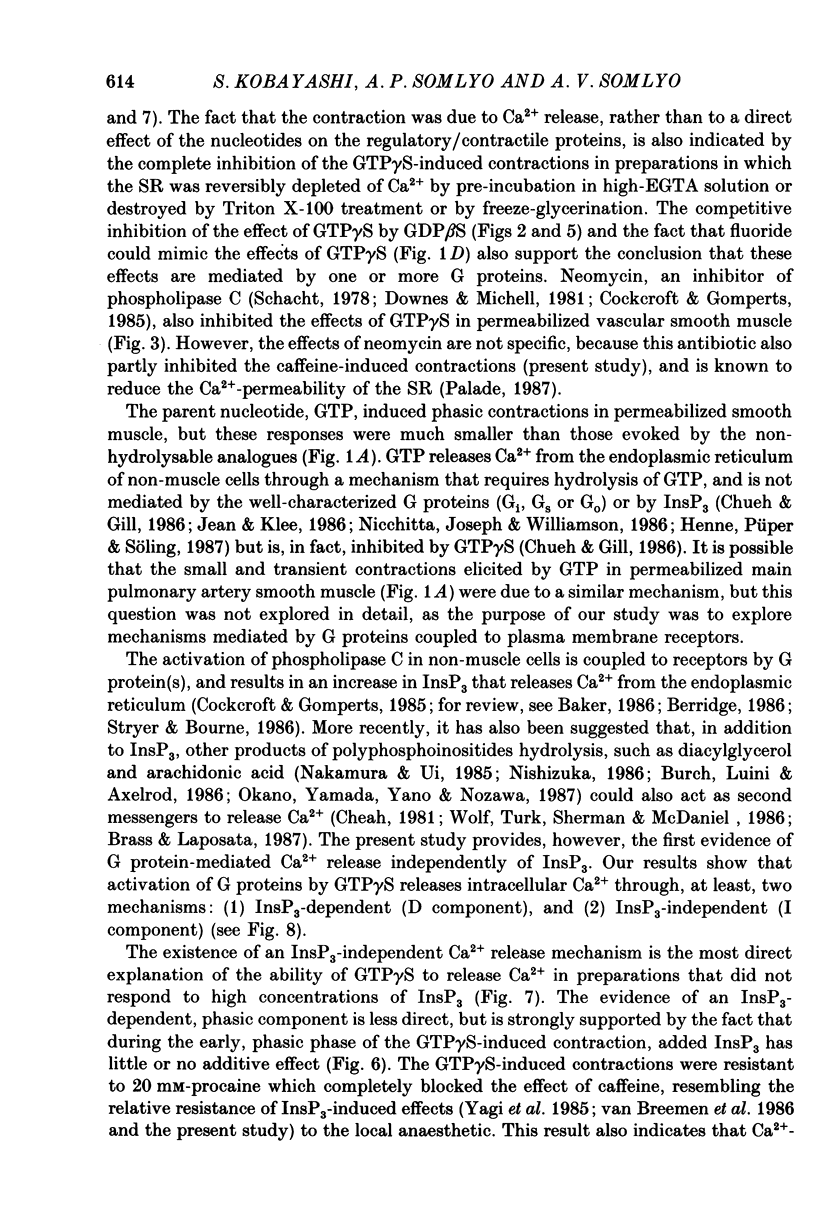Abstract
1. The effects of activation of guanine nucleotide-binding protein (G protein) by guanine nucleotides or sodium fluoride on the release of intracellular Ca2+ and on tension development were determined in chemically skinned strips of rabbit main pulmonary arteries (MPA). Ca2+ movements were monitored with Fura-2, as the change in free Ca2+ concentration in the bath medium surrounding the skinned MPA. 2. Sodium fluoride or non-hydrolysable analogues of GTP, guanosine 5'-[gamma-thio]triphosphate (GTP gamma S) and guanosine 5'-[beta,gamma-imido]triphosphate (GMP-PNP), induced sustained and dose-dependent contraction of skinned MPA. GTP (100 microM) induced transient contraction of skinned MPA. GTP gamma S did not contract intact MPA. We also confirmed that inositol 1,4,5-trisphosphate (InsP3) released sufficient Ca2+ to induce contraction of skinned, but not intact, MPA. 3. Guanosine 5'-[beta-thio]diphosphate (GDP beta S), a non-hydrolysable analogue of GDP that competitively inhibits the binding of guanine nucleotides to G proteins, inhibited the contractions induced by GTP gamma S. Neomycin (1 mM) inhibited the GTP gamma S-induced contractions, but also, to a lesser extent, contractions induced by caffeine. 4. Depletion of Ca2+ from the sarcoplasmic reticulum (SR) or treatment with Triton X-100 inhibited the GTP gamma S-induced contractions. The effects of Ca2+ depletion was reversible, while that of Triton X-100 was irreversible. GTP gamma S (up to 100 microM) had no apparent effect on the pCa-tension curve of freeze-glycerinated MPA. 5. GTP gamma S- or InsP3-induced contractions occurred in the presence of 20 mM-procaine, while this agent completely blocked the contraction induced by caffeine. 6. Both GTP gamma S and InsP3 induced an increase in the Fura-2 fluorescence signal of the bath medium surrounding the skinned MPA, indicating that GTP gamma S releases intracellular Ca2+. The release of Ca2+ induced by GTP gamma S was inhibited by GDP beta S. 7. During the initial phasic contraction induced by GTP gamma S, added InsP3 had little or no additive effect, in contrast to its additive effect during the latter sustained contraction induced by GTP gamma S.(ABSTRACT TRUNCATED AT 400 WORDS)
Full text
PDF


















Selected References
These references are in PubMed. This may not be the complete list of references from this article.
- Baker P. F. Intracellular signalling. GTP and calcium release. Nature. 1986 Apr 3;320(6061):395–395. doi: 10.1038/320395a0. [DOI] [PubMed] [Google Scholar]
- Berridge M. J. Inositol trisphosphate and calcium mobilization. J Cardiovasc Pharmacol. 1986;8 (Suppl 8):S85–S90. doi: 10.1097/00005344-198600088-00018. [DOI] [PubMed] [Google Scholar]
- Berridge M. J., Irvine R. F. Inositol trisphosphate, a novel second messenger in cellular signal transduction. Nature. 1984 Nov 22;312(5992):315–321. doi: 10.1038/312315a0. [DOI] [PubMed] [Google Scholar]
- Bigay J., Deterre P., Pfister C., Chabre M. Fluoroaluminates activate transducin-GDP by mimicking the gamma-phosphate of GTP in its binding site. FEBS Lett. 1985 Oct 28;191(2):181–185. doi: 10.1016/0014-5793(85)80004-1. [DOI] [PubMed] [Google Scholar]
- Bond M., Kitazawa T., Somlyo A. P., Somlyo A. V. Release and recycling of calcium by the sarcoplasmic reticulum in guinea-pig portal vein smooth muscle. J Physiol. 1984 Oct;355:677–695. doi: 10.1113/jphysiol.1984.sp015445. [DOI] [PMC free article] [PubMed] [Google Scholar]
- Brass L. F., Laposata M. Diacylglycerol causes Ca release from the platelet dense tubular system: comparisons with Ca release caused by inositol 1,4,5-triphosphate. Biochem Biophys Res Commun. 1987 Jan 15;142(1):7–14. doi: 10.1016/0006-291x(87)90444-x. [DOI] [PubMed] [Google Scholar]
- Burch R. M., Luini A., Axelrod J. Phospholipase A2 and phospholipase C are activated by distinct GTP-binding proteins in response to alpha 1-adrenergic stimulation in FRTL5 thyroid cells. Proc Natl Acad Sci U S A. 1986 Oct;83(19):7201–7205. doi: 10.1073/pnas.83.19.7201. [DOI] [PMC free article] [PubMed] [Google Scholar]
- Cardinaud R. A simple and rapid preparation of fully phosphorylated and fully dephosphorylated skeletal muscle myosin. Application to the preparation of a phosphorylated LC2-modified artificial isozyme. J Muscle Res Cell Motil. 1986 Oct;7(5):455–466. doi: 10.1007/BF01753588. [DOI] [PubMed] [Google Scholar]
- Casteels R., Raeymaekers L., Suzuki H., Van Eldere J. Tension response and 45Ca release in vascular smooth muscle incubated in Ca-free solution. Pflugers Arch. 1981 Dec;392(2):139–145. doi: 10.1007/BF00581262. [DOI] [PubMed] [Google Scholar]
- Cheah A. M. Effect of long chain unsaturated fatty acids on the calcium transport of sarcoplasmic reticulum. Biochim Biophys Acta. 1981 Nov 6;648(2):113–119. doi: 10.1016/0005-2736(81)90025-0. [DOI] [PubMed] [Google Scholar]
- Cockcroft S., Gomperts B. D. Role of guanine nucleotide binding protein in the activation of polyphosphoinositide phosphodiesterase. Nature. 1985 Apr 11;314(6011):534–536. doi: 10.1038/314534a0. [DOI] [PubMed] [Google Scholar]
- Devine C. E., Somlyo A. V., Somlyo A. P. Sarcoplasmic reticulum and excitation-contraction coupling in mammalian smooth muscles. J Cell Biol. 1972 Mar;52(3):690–718. doi: 10.1083/jcb.52.3.690. [DOI] [PMC free article] [PubMed] [Google Scholar]
- Di Virgilio F., Salviati G., Pozzan T., Volpe P. Is a guanine nucleotide-binding protein involved in excitation-contraction coupling in skeletal muscle? EMBO J. 1986 Feb;5(2):259–262. doi: 10.1002/j.1460-2075.1986.tb04207.x. [DOI] [PMC free article] [PubMed] [Google Scholar]
- Downes C. P., Michell R. H. The polyphosphoinositide phosphodiesterase of erythrocyte membranes. Biochem J. 1981 Jul 15;198(1):133–140. doi: 10.1042/bj1980133. [DOI] [PMC free article] [PubMed] [Google Scholar]
- Eckstein F., Cassel D., Levkovitz H., Lowe M., Selinger Z. Guanosine 5'-O-(2-thiodiphosphate). An inhibitor of adenylate cyclase stimulation by guanine nucleotides and fluoride ions. J Biol Chem. 1979 Oct 10;254(19):9829–9834. [PubMed] [Google Scholar]
- Fülle H. J., Höer D., Lache W., Rosenthal W., Schultz G., Oberdisse E. In vitro synthesis of 32P-labelled phosphatidylinositol 4,5-bisphosphate and its hydrolysis by smooth muscle membrane-bound phospholipase C. Biochem Biophys Res Commun. 1987 Jun 15;145(2):673–679. doi: 10.1016/0006-291x(87)91017-5. [DOI] [PubMed] [Google Scholar]
- Gilman A. G. G proteins and dual control of adenylate cyclase. Cell. 1984 Mar;36(3):577–579. doi: 10.1016/0092-8674(84)90336-2. [DOI] [PubMed] [Google Scholar]
- Goldman Y. E., Hibberd M. G., Trentham D. R. Relaxation of rabbit psoas muscle fibres from rigor by photochemical generation of adenosine-5'-triphosphate. J Physiol. 1984 Sep;354:577–604. doi: 10.1113/jphysiol.1984.sp015394. [DOI] [PMC free article] [PubMed] [Google Scholar]
- Grynkiewicz G., Poenie M., Tsien R. Y. A new generation of Ca2+ indicators with greatly improved fluorescence properties. J Biol Chem. 1985 Mar 25;260(6):3440–3450. [PubMed] [Google Scholar]
- Henne V., Piiper A., Söling H. D. Inositol 1,4,5-trisphosphate and 5'-GTP induce calcium release from different intracellular pools. FEBS Lett. 1987 Jun 22;218(1):153–158. doi: 10.1016/0014-5793(87)81037-2. [DOI] [PubMed] [Google Scholar]
- Higashijima T., Ferguson K. M., Sternweis P. C., Ross E. M., Smigel M. D., Gilman A. G. The effect of activating ligands on the intrinsic fluorescence of guanine nucleotide-binding regulatory proteins. J Biol Chem. 1987 Jan 15;262(2):752–756. [PubMed] [Google Scholar]
- Itoh T., Kuriyama H., Suzuki H. Differences and similarities in the noradrenaline- and caffeine-induced mechanical responses in the rabbit mesenteric artery. J Physiol. 1983 Apr;337:609–629. doi: 10.1113/jphysiol.1983.sp014645. [DOI] [PMC free article] [PubMed] [Google Scholar]
- Itoh T., Ueno H., Kuriyama H. Calcium-induced calcium release mechanism in vascular smooth muscles--assessments based on contractions evoked in intact and saponin-treated skinned muscles. Experientia. 1985 Aug 15;41(8):989–996. doi: 10.1007/BF01952119. [DOI] [PubMed] [Google Scholar]
- Jean T., Klee C. B. Calcium modulation of inositol 1,4,5-trisphosphate-induced calcium release from neuroblastoma x glioma hybrid (NG108-15) microsomes. J Biol Chem. 1986 Dec 15;261(35):16414–16420. [PubMed] [Google Scholar]
- Jones A. W., Somlyo A. P., Somlyo A. V. Potassium accumulation in smooth muscle and associated ultrastructural changes. J Physiol. 1973 Jul;232(2):247–273. doi: 10.1113/jphysiol.1973.sp010268. [DOI] [PMC free article] [PubMed] [Google Scholar]
- Kobayashi S., Kanaide H., Nakamura M. Complete overlap of caffeine- and K+ depolarization-sensitive intracellular calcium storage site in cultured rat arterial smooth muscle cells. J Biol Chem. 1986 Nov 25;261(33):15709–15713. [PubMed] [Google Scholar]
- Kowarski D., Shuman H., Somlyo A. P., Somlyo A. V. Calcium release by noradrenaline from central sarcoplasmic reticulum in rabbit main pulmonary artery smooth muscle. J Physiol. 1985 Sep;366:153–175. doi: 10.1113/jphysiol.1985.sp015790. [DOI] [PMC free article] [PubMed] [Google Scholar]
- Kuriyama H., Ito Y., Suzuki H., Kitamura K., Itoh T. Factors modifying contraction-relaxation cycle in vascular smooth muscles. Am J Physiol. 1982 Nov;243(5):H641–H662. doi: 10.1152/ajpheart.1982.243.5.H641. [DOI] [PubMed] [Google Scholar]
- Nakamura T., Ui M. Simultaneous inhibitions of inositol phospholipid breakdown, arachidonic acid release, and histamine secretion in mast cells by islet-activating protein, pertussis toxin. A possible involvement of the toxin-specific substrate in the Ca2+-mobilizing receptor-mediated biosignaling system. J Biol Chem. 1985 Mar 25;260(6):3584–3593. [PubMed] [Google Scholar]
- Nicchitta C. V., Joseph S. K., Williamson J. R. Polyethylene glycol-stimulated microsomal GTP hydrolysis. Relationship to GTP-mediated Ca2+ release. FEBS Lett. 1986 Dec 15;209(2):243–248. doi: 10.1016/0014-5793(86)81120-6. [DOI] [PubMed] [Google Scholar]
- Nishizuka Y. Studies and perspectives of protein kinase C. Science. 1986 Jul 18;233(4761):305–312. doi: 10.1126/science.3014651. [DOI] [PubMed] [Google Scholar]
- Okano Y., Yamada K., Yano K., Nozawa Y. Guanosine 5'-(gamma-thio)triphosphate stimulates arachidonic acid liberation in permeabilized rat peritoneal mast cells. Biochem Biophys Res Commun. 1987 Jun 30;145(3):1267–1275. doi: 10.1016/0006-291x(87)91574-9. [DOI] [PubMed] [Google Scholar]
- Palade P. Drug-induced Ca2+ release from isolated sarcoplasmic reticulum. III. Block of Ca2+-induced Ca2+ release by organic polyamines. J Biol Chem. 1987 May 5;262(13):6149–6154. [PubMed] [Google Scholar]
- Peterson J. W., 3rd Rate-limiting steps in the tension development of freeze-glycerinated vascular smooth muscle. J Gen Physiol. 1982 Mar;79(3):437–452. doi: 10.1085/jgp.79.3.437. [DOI] [PMC free article] [PubMed] [Google Scholar]
- Rüegg J. C., Sparrow M. P., Mrwa U. Cyclic-AMP mediated relaxation of chemically skinned fibers of smooth muscle. Pflugers Arch. 1981 May;390(2):198–201. doi: 10.1007/BF00590207. [DOI] [PubMed] [Google Scholar]
- Sasaguri T., Hirata M., Kuriyama H. Dependence on Ca2+ of the activities of phosphatidylinositol 4,5-bisphosphate phosphodiesterase and inositol 1,4,5-trisphosphate phosphatase in smooth muscles of the porcine coronary artery. Biochem J. 1985 Nov 1;231(3):497–503. doi: 10.1042/bj2310497. [DOI] [PMC free article] [PubMed] [Google Scholar]
- Schacht J. Purification of polyphosphoinositides by chromatography on immobilized neomycin. J Lipid Res. 1978 Nov;19(8):1063–1067. [PubMed] [Google Scholar]
- Somlyo A. P. Excitation-contraction coupling and the ultrastructure of smooth muscle. Circ Res. 1985 Oct;57(4):497–507. doi: 10.1161/01.res.57.4.497. [DOI] [PubMed] [Google Scholar]
- Somlyo A. P. The messenger across the gap. Nature. 1985 Jul 25;316(6026):298–299. doi: 10.1038/316298b0. [DOI] [PubMed] [Google Scholar]
- Somlyo A. V., Bond M., Somlyo A. P., Scarpa A. Inositol trisphosphate-induced calcium release and contraction in vascular smooth muscle. Proc Natl Acad Sci U S A. 1985 Aug;82(15):5231–5235. doi: 10.1073/pnas.82.15.5231. [DOI] [PMC free article] [PubMed] [Google Scholar]
- Somlyo A. V., Franzini-Armstrong C. New views of smooth muscle structure using freezing, deep-etching and rotary shadowing. Experientia. 1985 Jul 15;41(7):841–856. doi: 10.1007/BF01970000. [DOI] [PubMed] [Google Scholar]
- Somlyo A. V., Somlyo A. P. Electromechanical and pharmacomechanical coupling in vascular smooth muscle. J Pharmacol Exp Ther. 1968 Jan;159(1):129–145. [PubMed] [Google Scholar]
- Sternweis P. C., Gilman A. G. Aluminum: a requirement for activation of the regulatory component of adenylate cyclase by fluoride. Proc Natl Acad Sci U S A. 1982 Aug;79(16):4888–4891. doi: 10.1073/pnas.79.16.4888. [DOI] [PMC free article] [PubMed] [Google Scholar]
- Stryer L., Bourne H. R. G proteins: a family of signal transducers. Annu Rev Cell Biol. 1986;2:391–419. doi: 10.1146/annurev.cb.02.110186.002135. [DOI] [PubMed] [Google Scholar]
- Suematsu E., Hirata M., Hashimoto T., Kuriyama H. Inositol 1,4,5-trisphosphate releases Ca2+ from intracellular store sites in skinned single cells of porcine coronary artery. Biochem Biophys Res Commun. 1984 Apr 30;120(2):481–485. doi: 10.1016/0006-291x(84)91279-8. [DOI] [PubMed] [Google Scholar]
- Walker J. W., Somlyo A. V., Goldman Y. E., Somlyo A. P., Trentham D. R. Kinetics of smooth and skeletal muscle activation by laser pulse photolysis of caged inositol 1,4,5-trisphosphate. Nature. 1987 May 21;327(6119):249–252. doi: 10.1038/327249a0. [DOI] [PubMed] [Google Scholar]
- Wolf B. A., Turk J., Sherman W. R., McDaniel M. L. Intracellular Ca2+ mobilization by arachidonic acid. Comparison with myo-inositol 1,4,5-trisphosphate in isolated pancreatic islets. J Biol Chem. 1986 Mar 15;261(8):3501–3511. [PubMed] [Google Scholar]


